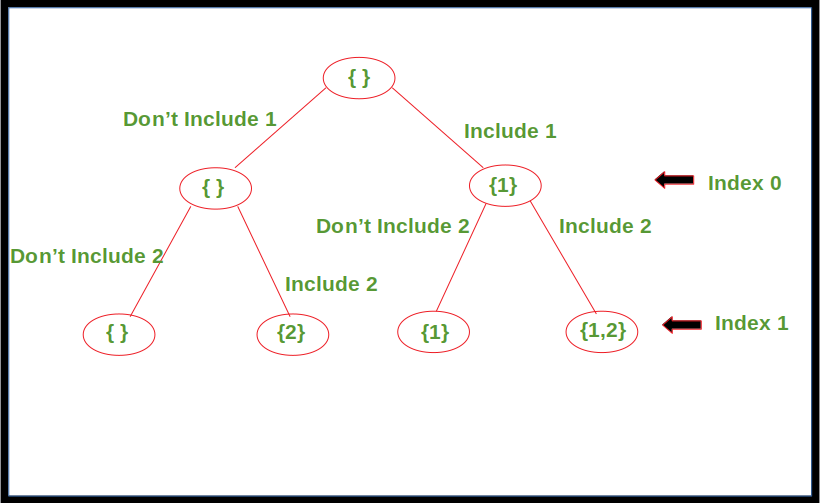本文概述
给定一个数组。任务是使用递归生成并打印给定数组的所有可能的子序列。
例子:
Input : [1, 2, 3]
Output : [3], [2], [2, 3], [1], [1, 3], [1, 2], [1, 2, 3]
Input : [1, 2]
Output : [2], [1], [1, 2]方法:
对于数组中的每个元素, 都有两种选择, 要么将其包含在子序列中, 要么不包含它。从索引0开始将其应用于数组中的每个元素, 直到到达最后一个索引。到达最后一个索引后, 打印子序列。
下图显示了数组的递归树,arr [] = {1, 2}.

下面是上述方法的实现。
C ++
//C++ code to print all possible
//subsequences for given array using
//recursion
#include <bits/stdc++.h>
using namespace std;
void printArray(vector<int> arr, int n)
{
for ( int i = 0; i <n; i++)
cout <<arr[i] <<" " ;
cout <<endl;
}
//Recursive function to print all
//possible subsequences for given array
void printSubsequences(vector<int> arr, int index, vector<int> subarr)
{
//Print the subsequence when reach
//the leaf of recursion tree
if (index == arr.size())
{
int l = subarr.size();
//Condition to avoid printing
//empty subsequence
if (l != 0)
printArray(subarr, l);
}
else
{
//Subsequence without including
//the element at current index
printSubsequences(arr, index + 1, subarr);
subarr.push_back(arr[index]);
//Subsequence including the element
//at current index
printSubsequences(arr, index + 1, subarr);
}
return ;
}
//Driver Code
int main()
{
vector<int> arr{1, 2, 3};
vector<int> b;
printSubsequences(arr, 0, b);
return 0;
}
//This code is contributed by
//sanjeev2552Python3
# Python3 code to print all possible
# subsequences for given array using
# recursion
# Recursive function to print all
# possible subsequences for given array
def printSubsequences(arr, index, subarr):
# Print the subsequence when reach
# the leaf of recursion tree
if index = = len (arr):
# Condition to avoid printing
# empty subsequence
if len (subarr) ! = 0 :
print (subarr)
else :
# Subsequence without including
# the element at current index
printSubsequences(arr, index + 1 , subarr)
# Subsequence including the element
# at current index
printSubsequences(arr, index + 1 , subarr + [arr[index]])
return
arr = [ 1 , 2 , 3 ]
printSubsequences(arr, 0 , [])
#This code is contributed by Mayank Tyagi输出如下:
[3]
[2]
[2, 3]
[1]
[1, 3]
[1, 2]
[1, 2, 3]时间复杂度:

首先, 你的面试准备可通过以下方式增强你的数据结构概念:Python DS课程。

![从字法上最小长度N的排列,使得对于正好为K个索引,a[i] a[i]+1](https://www.lsbin.com/wp-content/themes/begin%20lts/img/loading.png)